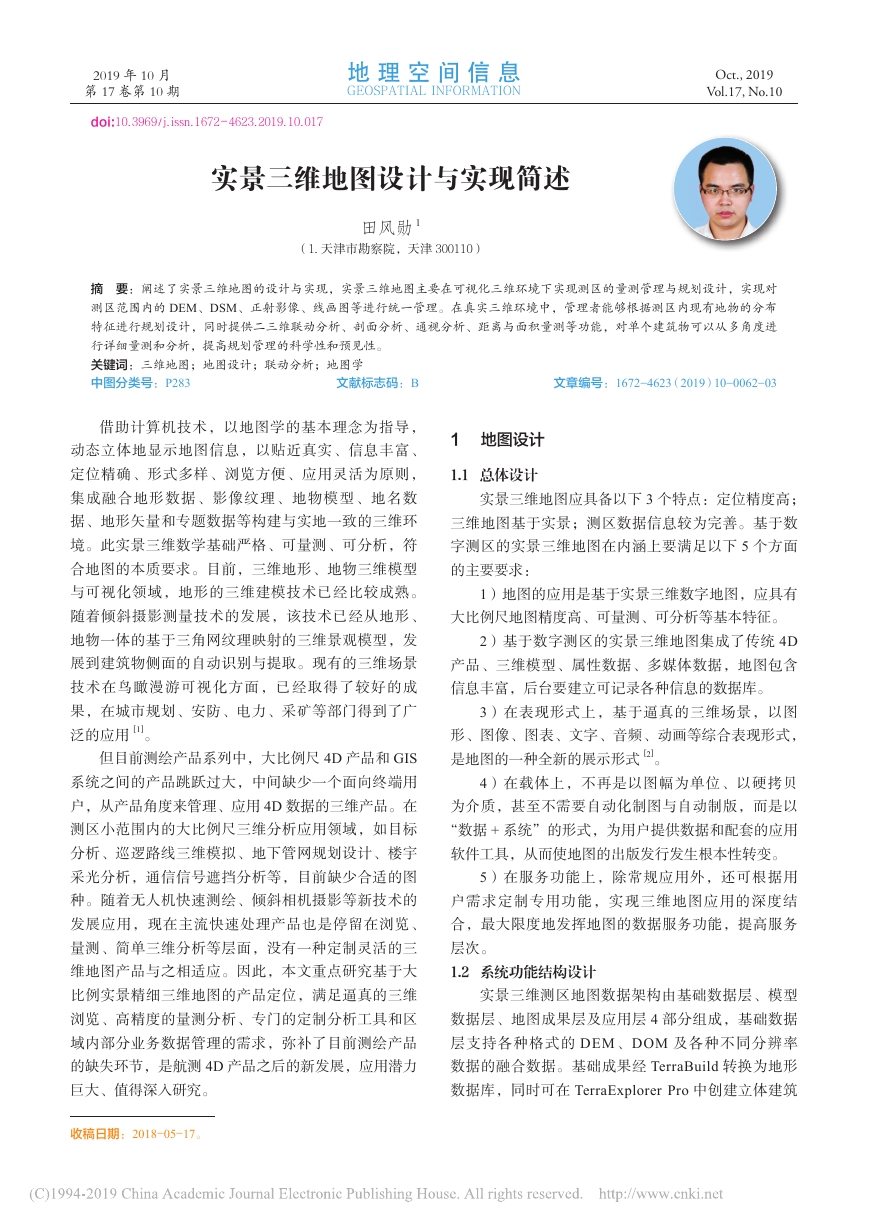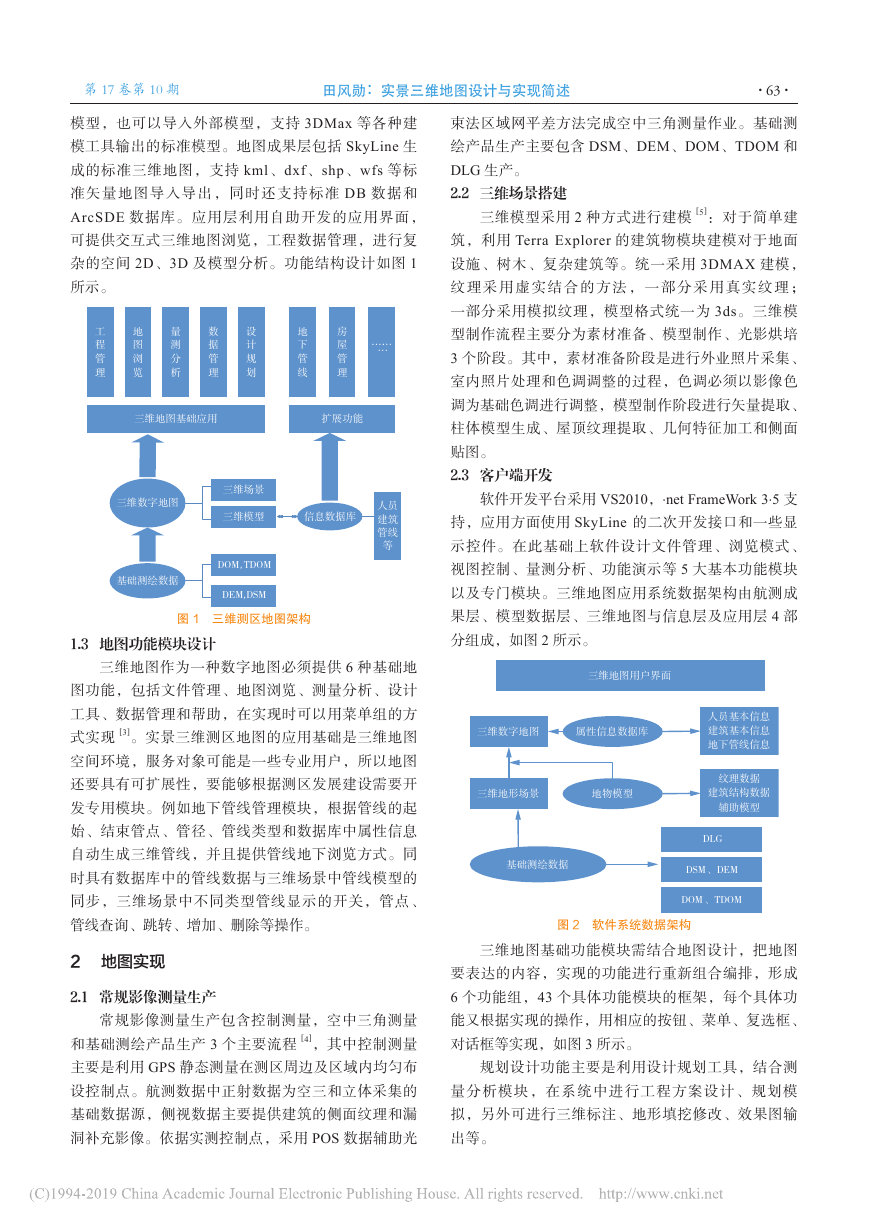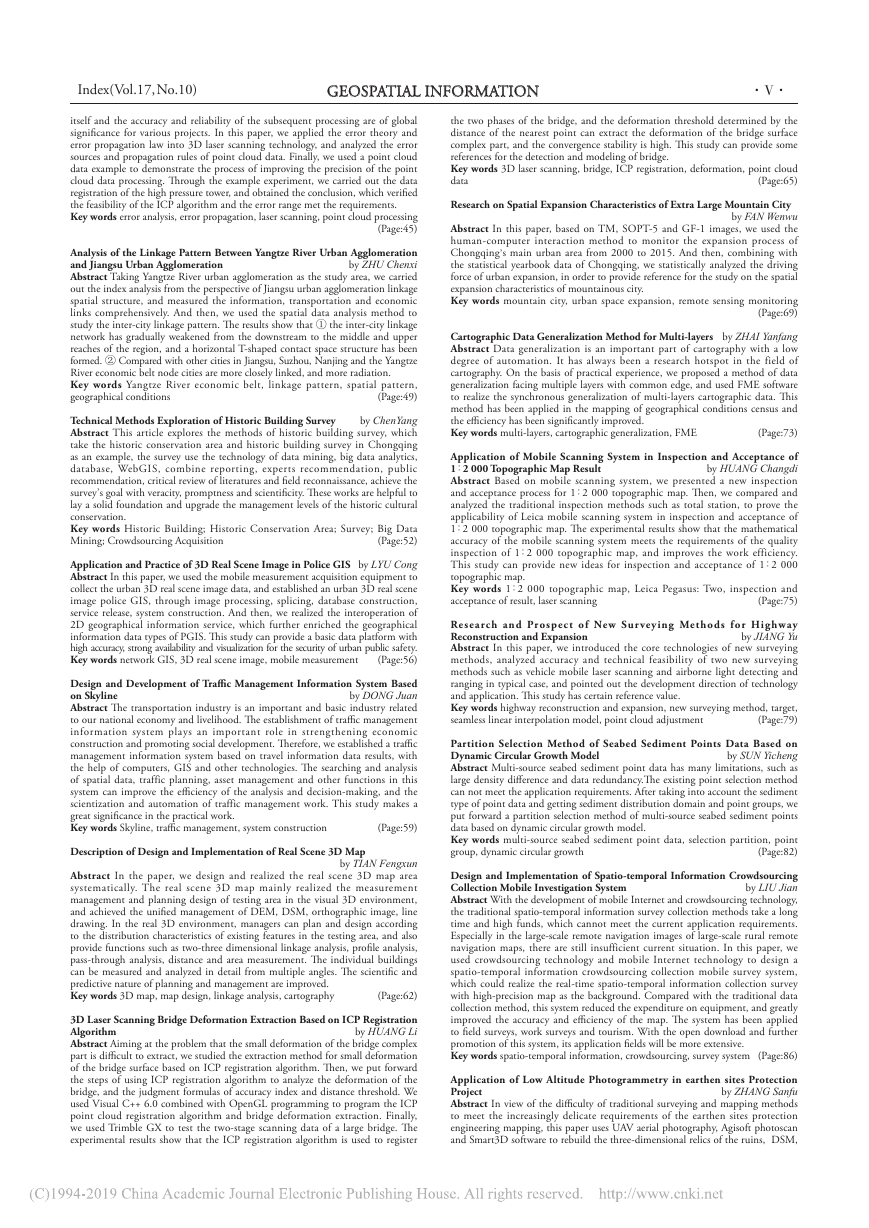doi:10.3969/j.issn.1672-4623.2019.10.017
实景三维地图设计与实现简述
田风勋 1
(1. 天津市勘察院,天津 300110)
摘 要:阐述了实景三维地图的设计与实现,实景三维地图主要在可视化三维环境下实现测区的量测管理与规划设计,实现对
测区范围内的 DEM、DSM、正射影像、线画图等进行统一管理。在真实三维环境中,管理者能够根据测区内现有地物的分布
特征进行规划设计,同时提供二三维联动分析、剖面分析、通视分析、距离与面积量测等功能,对单个建筑物可以从多角度进
行详细量测和分析,提高规划管理的科学性和预见性。
关键词:三维地图;地图设计;联动分析;地图学
中图分类号:P283 文献标志码:B
文章编号:1672-4623(2019)10-0062-03
借助计算机技术,以地图学的基本理念为指导,
动态立体地显示地图信息,以贴近真实、信息丰富、
定位精确、形式多样、浏览方便、应用灵活为原则,
集成融合地形数据、影像纹理、地物模型、地名数
据、地形矢量和专题数据等构建与实地一致的三维环
境。此实景三维数学基础严格、可量测、可分析,符
合地图的本质要求。目前,三维地形、地物三维模型
与可视化领域,地形的三维建模技术已经比较成熟。
随着倾斜摄影测量技术的发展,该技术已经从地形、
地物一体的基于三角网纹理映射的三维景观模型,发
展到建筑物侧面的自动识别与提取。现有的三维场景
技术在鸟瞰漫游可视化方面,已经取得了较好的成
果,在城市规划、安防、电力、采矿等部门得到了广
泛的应用 [1]。
但目前测绘产品系列中,大比例尺 4D 产品和 GIS
系统之间的产品跳跃过大,中间缺少一个面向终端用
户,从产品角度来管理、应用 4D 数据的三维产品。在
测区小范围内的大比例尺三维分析应用领域,如目标
分析、巡逻路线三维模拟、地下管网规划设计、楼宇
采光分析,通信信号遮挡分析等,目前缺少合适的图
种。随着无人机快速测绘、倾斜相机摄影等新技术的
发展应用,现在主流快速处理产品也是停留在浏览、
量测、简单三维分析等层面,没有一种定制灵活的三
维地图产品与之相适应。因此,本文重点研究基于大
比例实景精细三维地图的产品定位,满足逼真的三维
浏览、高精度的量测分析、专门的定制分析工具和区
域内部分业务数据管理的需求,弥补了目前测绘产品
的缺失环节,是航测 4D 产品之后的新发展,应用潜力
巨大、值得深入研究。
收稿日期:2018-05-17。
1 地图设计
1.1 总体设计
实景三维地图应具备以下 3 个特点:定位精度高;
三维地图基于实景;测区数据信息较为完善。基于数
字测区的实景三维地图在内涵上要满足以下 5 个方面
的主要要求:
1)地图的应用是基于实景三维数字地图,应具有
大比例尺地图精度高、可量测、可分析等基本特征。
2)基于数字测区的实景三维地图集成了传统 4D
产品、三维模型、属性数据、多媒体数据,地图包含
信息丰富,后台要建立可记录各种信息的数据库。
3)在表现形式上,基于逼真的三维场景,以图
形、图像、图表、文字、音频、动画等综合表现形式,
是地图的一种全新的展示形式 [2]。
4)在载体上,不再是以图幅为单位、以硬拷贝
为介质,甚至不需要自动化制图与自动制版,而是以
“数据 + 系统”的形式,为用户提供数据和配套的应用
软件工具,从而使地图的出版发行发生根本性转变。
5)在服务功能上,除常规应用外,还可根据用
户需求定制专用功能,实现三维地图应用的深度结
合,最大限度地发挥地图的数据服务功能,提高服务
层次。
1.2 系统功能结构设计
实景三维测区地图数据架构由基础数据层、模型
数据层、地图成果层及应用层 4 部分组成,基础数据
层支持各种格式的 DEM、 DOM 及各种不同分辨率
数据的融合数据。基础成果经 TerraBuild 转换为地形
数据库,同时可在 TerraExplorer Pro 中创建立体建筑
地理空间信息GEOSPATIAL INFORMATION2019年10月第17卷第10期Oct.,2019Vol.17,No.10�
田风勋:实景三维地图设计与实现简述
·63·
模型,也可以导入外部模型,支持 3DMax 等各种建
模工具输出的标准模型。地图成果层包括 SkyLine 生
成的标准三维地图,支持 kml、dxf、shp、wfs 等标
准矢量地图导入导出,同时还支持标准 DB 数据和
ArcSDE 数据库。应用层利用自助开发的应用界面,
可提供交互式三维地图浏览,工程数据管理,进行复
杂的空间 2D、3D 及模型分析。功能结构设计如图 1
所示。
图 1 三维测区地图架构
1.3 地图功能模块设计
三维地图作为一种数字地图必须提供 6 种基础地
图功能,包括文件管理、地图浏览、测量分析、设计
工具、数据管理和帮助,在实现时可以用菜单组的方
式实现 [3]。实景三维测区地图的应用基础是三维地图
空间环境,服务对象可能是一些专业用户,所以地图
还要具有可扩展性,要能够根据测区发展建设需要开
发专用模块。例如地下管线管理模块,根据管线的起
始、结束管点、管径、管线类型和数据库中属性信息
自动生成三维管线,并且提供管线地下浏览方式。同
时具有数据库中的管线数据与三维场景中管线模型的
同步,三维场景中不同类型管线显示的开关,管点、
管线查询、跳转、增加、删除等操作。
2 地图实现
2.1 常规影像测量生产
常规影像测量生产包含控制测量,空中三角测量
和基础测绘产品生产 3 个主要流程 [4],其中控制测量
主要是利用 GPS 静态测量在测区周边及区域内均匀布
设控制点。航测数据中正射数据为空三和立体采集的
基础数据源,侧视数据主要提供建筑的侧面纹理和漏
洞补充影像。依据实测控制点,采用 POS 数据辅助光
束法区域网平差方法完成空中三角测量作业。基础测
绘产品生产主要包含 DSM、DEM、DOM、TDOM 和
DLG 生产。
2.2 三维场景搭建
三维模型采用 2 种方式进行建模 [5]:对于简单建
筑,利用 Terra Explorer 的建筑物模块建模对于地面
设施、树木、复杂建筑等。统一采用 3DMAX 建模,
纹理采用虚实结合的方法,一部分采用真实纹理;
一部分采用模拟纹理,模型格式统一为 3ds。三维模
型制作流程主要分为素材准备、模型制作、光影烘培
3 个阶段。其中,素材准备阶段是进行外业照片采集、
室内照片处理和色调调整的过程,色调必须以影像色
调为基础色调进行调整,模型制作阶段进行矢量提取、
柱体模型生成、屋顶纹理提取、几何特征加工和侧面
贴图。
2.3 客户端开发
软件开发平台采用 VS2010,.net FrameWork 3.5 支
持,应用方面使用 SkyLine 的二次开发接口和一些显
示控件。在此基础上软件设计文件管理、浏览模式、
视图控制、量测分析、功能演示等 5 大基本功能模块
以及专门模块。三维地图应用系统数据架构由航测成
果层、模型数据层、三维地图与信息层及应用层 4 部
分组成,如图 2 所示。
图 2 软件系统数据架构
三维地图基础功能模块需结合地图设计,把地图
要表达的内容,实现的功能进行重新组合编排,形成
6 个功能组,43 个具体功能模块的框架,每个具体功
能又根据实现的操作,用相应的按钮、菜单、复选框、
对话框等实现,如图 3 所示。
规划设计功能主要是利用设计规划工具,结合测
量分析模块,在系统中进行工程方案设计、规划模
拟,另外可进行三维标注、地形填挖修改、效果图输
出等。
第17卷第10期�
·64·
图 3 软件基础功能框架
2.4 质量控制
三维系统中误差源不仅来自空间数据,还来自地
形图、遥感影像的精度和处理,同时会受到纹理数据
的采集与编辑、三维几何建模精度的影响 [6]。针对基
础数据 DEM、DSM、DOM、DLG 的质量控制,主要
采用空中三角测量质量控制方法、DSM 采集质量控制
方法、DOM 制作质量控制方法、DLG 采集质量控制
方法等 [7]。
3 结 语
于现有“PF”、“GXP”等数字摄影测量系统生产平台,
运用 3DMax、SketchUp 等建模工具,用“C #”语言辅
以 SkyLine 开发包作为集成平台,以此为背景,从实
景三维地图的定位、设计以及地图实现方面展开研究,
设计了实景三维地图的功能框架和要素结构,探讨了
实现实景三维测区地图在量测分析、规划设计、管理
等方面应用的路径。下一步还需要考虑加强自动建模
技术、管理应用功能以及基础数据加密保护方面的工
作,从而进一步提升实景三维地图系统的实用性 [8]。
参考文献
[1] 廖明伟, 廖明, 万敏. 空地一体化倾斜摄影与实景三维融合关
键技术探讨[J]. 江西测绘, 2017(1):2-3
[2] 杨国东, 王民水. 倾斜摄影测量技术应用及展望[J]. 测绘与空
间地理信息, 2016,39(1):13-15
[3] 邓非, 李朋龙, 阚酉浔, 等.数字建筑模型整体投影真正射
影像制作中的遮蔽检测方法[J]. 武汉大学学报 ( 信息科学
版 ),2017,42(1):97-102
[4] 李宏旭, 杨李东. 基于 CityEngine 的三维城市规划设计与研
究[J]. 测绘与空间地理信息, 2016(5):55-57
[5] 朱涛, 黎恒明, 杜延峰, 等. 基于 Skyline 的三维实景地图创建[J].
现代计算机, 2017(13):42-45
[6] 曲林, 冯洋, 支玲美, 等.基于无人机倾斜摄影数据的实景
三维建模研究[J]. 测绘与空间地理信息, 2015(3):38-39
[7] 汪雯琦, 冯琰, 顾星晔, 等. 上海市三维城市规划辅助审批系
统建设与应用研究[J]. 测绘与空间地理信息, 2013(7):97-100
[8] 刘润东. 实景三维新型测绘能力建设及典型应用[J]. 测绘与
空间地理信息, 2017,40(8):159-161
本文结合航测专业产品特点与地图制图要求,基
作者简介:田风勋,工程师,主要从事工程测绘工作。
(上接第 51 页) 需要充分对接上海的有效资源,利
用所处地理优势,加强完善与长江中游、甚至上游城
市群的联系。另一方面,加强江苏省协同长三角城市
群一体化建设,形成中心明确、沟通无碍、协同合作
的网络式区域体系。
参考文献
[1] 甄峰, 王波, 陈映雪. 基于网络社会空间的中国城市网络特
征——以新浪微博为例[J]. 地理学报, 2012,67(8):1 031-1 043
[2] 熊丽芳, 甄峰, 王波, 等. 基于百度指数的长三角核心区城市
网络特征研究[J]. 经济地理, 2013,33(7):67-73
[3] 朱杰. 江苏省城市经济影响区域变化[J]. 地理学报,2007,
10(62):1 023-1 033
[6] 周一星, 张莉. 改革开放条件下的中国城市经济[J]. 地理学报,
2003,19(37):1-5
[7] 唐娟, 马晓冬, 朱传耿, 等. 淮海经济区的城市经济联系格局
分析[J]. 城市发展研究, 2009,29 (5):18-23
[8] 孟德友, 陆玉麒. 基于铁路客运网络的省际可达性及经济联
系格局[J]. 地理研究, 2012,31(1):107-122
[9] 邹琳, 曾刚, 曹贤忠, 等. 长江经济带的经济联系网络空间特
征分析[J]. 经济地理, 2015,35(6):1-7
[10] 孟德友, 陆玉麒. 基于引力模型的江苏区域经济联系强度与
方向[J]. 地理科学进展, 2009,28(5):697-704
[11] 刘承良, 余瑞林, 熊剑平, 等. 武汉都市圈经济联系的空间结
构[J]. 地理研究, 2007(1):197-209
[12] 刘承良. 武汉都市圈经济联系时空演变特征分析[J]. 人文地
理, 2006(6):108-114
[13] 欧向军, 薛丽萍, 顾雯娟. 江苏省县市经济联系的空间特征[J].
[4] 董青, 刘海珍, 刘加珍, 等. 基于空间相互作用的中国城市群
经济地理, 2015,35(8):24-31
体系空间结构研究[J]. 经济地理, 2010,30(6):926-932
[5] 顾朝林, 庞海峰. 基于重力模型的中国城市体系空间联系与
层域划分[J]. 地理研究, 2008,1(27):1-12
第一作者简介:朱晨曦,高级工程师,主要从事地理信息共享与
应用、地理国情监测、国土资源利用等研究。
地理空间信息第17卷第10期�
itself and the accuracy and reliability of the subsequent processing are of global
significance for various projects. In this paper, we applied the error theory and
error propagation law into 3D laser scanning technology, and analyzed the error
sources and propagation rules of point cloud data. Finally, we used a point cloud
data example to demonstrate the process of improving the precision of the point
cloud data processing. Through the example experiment, we carried out the data
registration of the high pressure tower, and obtained the conclusion, which verified
the feasibility of the ICP algorithm and the error range met the requirements.
Key words error analysis, error propagation, laser scanning, point cloud processing
(Page:45)
Analysis of the Linkage Pattern Between Yangtze River Urban Agglomeration
by ZHU Chenxi
and Jiangsu Urban Agglomeration
Abstract Taking Yangtze River urban agglomeration as the study area, we carried
out the index analysis from the perspective of Jiangsu urban agglomeration linkage
spatial structure, and measured the information, transportation and economic
links comprehensively. And then, we used the spatial data analysis method to
study the inter-city linkage pattern. The results show that ① the inter-city linkage
network has gradually weakened from the downstream to the middle and upper
reaches of the region, and a horizontal T-shaped contact space structure has been
formed. ② Compared with other cities in Jiangsu, Suzhou, Nanjing and the Yangtze
River economic belt node cities are more closely linked, and more radiation.
Key words Yangtze River economic belt, linkage pattern, spatial pattern,
geographical conditions
(Page:49)
by ChenYang
Technical Methods Exploration of Historic Building Survey
Abstract This article explores the methods of historic building survey, which
take the historic conservation area and historic building survey in Chongqing
as an example, the survey use the technology of data mining, big data analytics,
database, WebGIS, combine reporting, experts recommendation, public
recommendation, critical review of literatures and field reconnaissance, achieve the
survey’s goal with veracity, promptness and scientificity. These works are helpful to
lay a solid foundation and upgrade the management levels of the historic cultural
conservation.
Key words Historic Building; Historic Conservation Area; Survey; Big Data
Mining; Crowdsourcing Acquisition
(Page:52)
Application and Practice of 3D Real Scene Image in Police GIS by LYU Cong
Abstract In this paper, we used the mobile measurement acquisition equipment to
collect the urban 3D real scene image data, and established an urban 3D real scene
image police GIS, through image processing, splicing, database construction,
service release, system construction. And then, we realized the interoperation of
2D geographical information service, which further enriched the geographical
information data types of PGIS. This study can provide a basic data platform with
high accuracy, strong availability and visualization for the security of urban public safety.
Key words network GIS, 3D real scene image, mobile measurement
(Page:56)
Design and Development of Traffic Management Information System Based
by DONG Juan
on Skyline
Abstract The transportation industry is an important and basic industry related
to our national economy and livelihood. The establishment of traffic management
information system plays an important role in strengthening economic
construction and promoting social development. Therefore, we established a traffic
management information system based on travel information data results, with
the help of computers, GIS and other technologies. The searching and analysis
of spatial data, traffic planning, asset management and other functions in this
system can improve the efficiency of the analysis and decision-making, and the
scientization and automation of traffic management work. This study makes a
great significance in the practical work.
Key words Skyline, traffic management, system construction
(Page:59)
Description of Design and Implementation of Real Scene 3D Map
by TIAN Fengxun
Abstract In the paper, we design and realized the real scene 3D map area
systematically. The real scene 3D map mainly realized the measurement
management and planning design of testing area in the visual 3D environment,
and achieved the unified management of DEM, DSM, orthographic image, line
drawing. In the real 3D environment, managers can plan and design according
to the distribution characteristics of existing features in the testing area, and also
provide functions such as two-three dimensional linkage analysis, profile analysis,
pass-through analysis, distance and area measurement. The individual buildings
can be measured and analyzed in detail from multiple angles. The scientific and
predictive nature of planning and management are improved.
Key words 3D map, map design, linkage analysis, cartography
(Page:62)
3D Laser Scanning Bridge Deformation Extraction Based on ICP Registration
by HUANG Li
Algorithm
Abstract Aiming at the problem that the small deformation of the bridge complex
part is difficult to extract, we studied the extraction method for small deformation
of the bridge surface based on ICP registration algorithm. Then, we put forward
the steps of using ICP registration algorithm to analyze the deformation of the
bridge, and the judgment formulas of accuracy index and distance threshold. We
used Visual C++ 6.0 combined with OpenGL programming to program the ICP
point cloud registration algorithm and bridge deformation extraction. Finally,
we used Trimble GX to test the two-stage scanning data of a large bridge. The
experimental results show that the ICP registration algorithm is used to register
·V·
the two phases of the bridge, and the deformation threshold determined by the
distance of the nearest point can extract the deformation of the bridge surface
complex part, and the convergence stability is high. This study can provide some
references for the detection and modeling of bridge.
Key words 3D laser scanning, bridge, ICP registration, deformation, point cloud
data
(Page:65)
Research on Spatial Expansion Characteristics of Extra Large Mountain City
by FAN Wenwu
Abstract In this paper, based on TM, SOPT-5 and GF-1 images, we used the
human-computer interaction method to monitor the expansion process of
Chongqing’s main urban area from 2000 to 2015. And then, combining with
the statistical yearbook data of Chongqing, we statistically analyzed the driving
force of urban expansion, in order to provide reference for the study on the spatial
expansion characteristics of mountainous city.
Key words mountain city, urban space expansion, remote sensing monitoring
(Page:69)
Cartographic Data Generalization Method for Multi-layers by ZHAI Yanfang
Abstract Data generalization is an important part of cartography with a low
degree of automation. It has always been a research hotspot in the field of
cartography. On the basis of practical experience, we proposed a method of data
generalization facing multiple layers with common edge, and used FME software
to realize the synchronous generalization of multi-layers cartographic data. This
method has been applied in the mapping of geographical conditions census and
the efficiency has been significantly improved.
Key words multi-layers, cartographic generalization, FME
(Page:73)
Application of Mobile Scanning System in Inspection and Acceptance of
by HUANG Changdi
1∶2 000 Topographic Map Result
Abstract Based on mobile scanning system, we presented a new inspection
and acceptance process for 1∶2 000 topographic map. Then, we compared and
analyzed the traditional inspection methods such as total station, to prove the
applicability of Leica mobile scanning system in inspection and acceptance of
1∶2 000 topographic map. The experimental results show that the mathematical
accuracy of the mobile scanning system meets the requirements of the quality
inspection of 1∶2 000 topographic map, and improves the work efficiency.
This study can provide new ideas for inspection and acceptance of 1∶2 000
topographic map.
Key words 1∶2 000 topographic map, Leica Pegasus: Two, inspection and
acceptance of result, laser scanning
(Page:75)
Research and Prospect of New Surveying Methods for Highway
by JIANG Yu
Reconstruction and Expansion
Abstract In this paper, we introduced the core technologies of new surveying
methods, analyzed accuracy and technical feasibility of two new surveying
methods such as vehicle mobile laser scanning and airborne light detecting and
ranging in typical case, and pointed out the development direction of technology
and application. This study has certain reference value.
Key words highway reconstruction and expansion, new surveying method, target,
(Page:79)
seamless linear interpolation model, point cloud adjustment
Partition Selection Method of Seabed Sediment Points Data Based on
by SUN Yicheng
Dynamic Circular Growth Model
Abstract Multi-source seabed sediment point data has many limitations, such as
large density difference and data redundancy.The existing point selection method
can not meet the application requirements. After taking into account the sediment
type of point data and getting sediment distribution domain and point groups, we
put forward a partition selection method of multi-source seabed sediment points
data based on dynamic circular growth model.
Key words multi-source seabed sediment point data, selection partition, point
group, dynamic circular growth
(Page:82)
Design and Implementation of Spatio-temporal Information Crowdsourcing
by LIU Jian
Collection Mobile Investigation System
Abstract With the development of mobile Internet and crowdsourcing technology,
the traditional spatio-temporal information survey collection methods take a long
time and high funds, which cannot meet the current application requirements.
Especially in the large-scale remote navigation images of large-scale rural remote
navigation maps, there are still insufficient current situation. In this paper, we
used crowdsourcing technology and mobile Internet technology to design a
spatio-temporal information crowdsourcing collection mobile survey system,
which could realize the real-time spatio-temporal information collection survey
with high-precision map as the background. Compared with the traditional data
collection method, this system reduced the expenditure on equipment, and greatly
improved the accuracy and efficiency of the map. The system has been applied
to field surveys, work surveys and tourism. With the open download and further
promotion of this system, its application fields will be more extensive.
Key words spatio-temporal information, crowdsourcing, survey system (Page:86)
Application of Low Altitude Photogrammetry in earthen sites Protection
by ZHANG Sanfu
Project
Abstract In view of the difficulty of traditional surveying and mapping methods
to meet the increasingly delicate requirements of the earthen sites protection
engineering mapping, this paper uses UAV aerial photography, Agisoft photoscan
and Smart3D software to rebuild the three-dimensional relics of the ruins, DSM,
Index(Vol.17,No.10)GEOSPATIAL INFORMATION�








 2023年江西萍乡中考道德与法治真题及答案.doc
2023年江西萍乡中考道德与法治真题及答案.doc 2012年重庆南川中考生物真题及答案.doc
2012年重庆南川中考生物真题及答案.doc 2013年江西师范大学地理学综合及文艺理论基础考研真题.doc
2013年江西师范大学地理学综合及文艺理论基础考研真题.doc 2020年四川甘孜小升初语文真题及答案I卷.doc
2020年四川甘孜小升初语文真题及答案I卷.doc 2020年注册岩土工程师专业基础考试真题及答案.doc
2020年注册岩土工程师专业基础考试真题及答案.doc 2023-2024学年福建省厦门市九年级上学期数学月考试题及答案.doc
2023-2024学年福建省厦门市九年级上学期数学月考试题及答案.doc 2021-2022学年辽宁省沈阳市大东区九年级上学期语文期末试题及答案.doc
2021-2022学年辽宁省沈阳市大东区九年级上学期语文期末试题及答案.doc 2022-2023学年北京东城区初三第一学期物理期末试卷及答案.doc
2022-2023学年北京东城区初三第一学期物理期末试卷及答案.doc 2018上半年江西教师资格初中地理学科知识与教学能力真题及答案.doc
2018上半年江西教师资格初中地理学科知识与教学能力真题及答案.doc 2012年河北国家公务员申论考试真题及答案-省级.doc
2012年河北国家公务员申论考试真题及答案-省级.doc 2020-2021学年江苏省扬州市江都区邵樊片九年级上学期数学第一次质量检测试题及答案.doc
2020-2021学年江苏省扬州市江都区邵樊片九年级上学期数学第一次质量检测试题及答案.doc 2022下半年黑龙江教师资格证中学综合素质真题及答案.doc
2022下半年黑龙江教师资格证中学综合素质真题及答案.doc